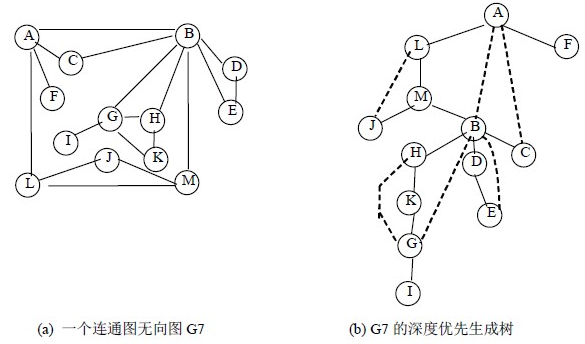寻找无向连通图的割点
2015-11-11 16:48
246 查看
无向连通图的割点又被成为关节点(articulation point), 移除关节点,则原连通图变成两个连通分量, 一个没有关节点的连通图被成为重连通图 (biconnected graph)

要寻找无向连通图中所有的关节点,比较便捷的方法是利用一次深度优先遍历,找到所有关节点
对于节点u,及其子节点v, u->v, 可以用数组dfn[u]来表示当前u的遍历序列号,用low[u]表示u及u的子节点通过非tree edge所能找到的最早的祖先节点的序列号, 如果u是关节点,则有两种情况:
1. 如果u是根节点,且u有两棵及以上的子树,则节点u为关节点,很明显,移除u会使其两棵子树变成不连通的两个连通分量
2. 如果对于节点v, low[v]的值 >= dfn[u], 说明v及其子节点最多能指到节点u, 没有其他路径能指到u的祖先,则移除u,其子节点v会成为独立的连通分量
得到公式: low[u] = min (
dfn[u],
low[v], u -> v 是tree edge, 即节点v以前未被dfs遍历过, 此时low[u] = min(low[u], low[v])
dfn[v], u -> v 是back edge, 即节点v已经被访问过, 此时low[u] = min(low[u], dfn[v]),
为什么不是low[v]而是dfn[v], 因为此时节点v已经被访问过了,说明 u->v是条回边,v是当前节点u的祖先,我们直接取该祖先的遍历序列值即可
)
下表给出图(a)对应的dfn与low数组值。
辅助类Bag

要寻找无向连通图中所有的关节点,比较便捷的方法是利用一次深度优先遍历,找到所有关节点
对于节点u,及其子节点v, u->v, 可以用数组dfn[u]来表示当前u的遍历序列号,用low[u]表示u及u的子节点通过非tree edge所能找到的最早的祖先节点的序列号, 如果u是关节点,则有两种情况:
1. 如果u是根节点,且u有两棵及以上的子树,则节点u为关节点,很明显,移除u会使其两棵子树变成不连通的两个连通分量
2. 如果对于节点v, low[v]的值 >= dfn[u], 说明v及其子节点最多能指到节点u, 没有其他路径能指到u的祖先,则移除u,其子节点v会成为独立的连通分量
得到公式: low[u] = min (
dfn[u],
low[v], u -> v 是tree edge, 即节点v以前未被dfs遍历过, 此时low[u] = min(low[u], low[v])
dfn[v], u -> v 是back edge, 即节点v已经被访问过, 此时low[u] = min(low[u], dfn[v]),
为什么不是low[v]而是dfn[v], 因为此时节点v已经被访问过了,说明 u->v是条回边,v是当前节点u的祖先,我们直接取该祖先的遍历序列值即可
)
下表给出图(a)对应的dfn与low数组值。
| i | 0 | 1 | 2 | 3 | 4 | 5 | 6 | 7 | 8 | 9 | 10 | 11 | 12 |
|---|---|---|---|---|---|---|---|---|---|---|---|---|---|
| vertex | A | B | C | D | E | F | G | H | I | J | K | L | M |
| dfn[i] | 1 | 5 | 12 | 10 | 11 | 13 | 8 | 6 | 9 | 4 | 7 | 2 | 3 |
| low[i] | 1 | 1 | 1 | 5 | 5 | 1 | 5 | 5 | 8 | 2 | 5 | 1 | 1 |
package com.rui.microsoft;
public class Test39_FindCutPoints {
public static void main(String[] args) {
UndirectedGraph dGraph = new UndirectedGraph(5);
dGraph.addEdge(0, 1);
dGraph.addEdge(1, 2);
dGraph.addEdge(2, 0);
dGraph.addEdge(0, 3);
dGraph.addEdge(3, 4);
dGraph.tarjan(0);
for(int i = 0; i < dGraph.V; i++){
if(dGraph.APs[i]){
System.out.println(" " + i);
}
}
}
}
class UndirectedGraph{
int V;
Bag<Integer>[] adj;
boolean[] visited;
int[] dfn;
int[] low;
int[] parents;
boolean[] APs;
int order = 0;
public UndirectedGraph(int size) {
this.V = size;
this.adj = new Bag[size];
this.dfn = new int[size];
this.low = new int[size];
this.parents = new int[size];
this.visited = new boolean[size];
this.APs = new boolean[size];
for(int i = 0; i < size; i++){
this.adj[i] = new Bag<Integer>();
this.parents[i] = -1;
this.APs[i] = false;
}
}
void addEdge(int from, int to){
adj[from].add(to);
adj[to].add(from);
}
void tarjan(int u){
dfn[u] = low[u] = ++order;
visited[u] = true;
int childs = 0;
//dfs
for(int v: this.adj[u]){
if(!visited[v]){
childs++;
parents[v] = u;
tarjan(v);
//after dfs the subtree of v
low[u] = min(low[u], low[v]);
//check
if(parents[u] == -1 && childs > 1){
APs[u] = true;
}
if(parents[u] != -1 && dfn[u] <= low[v]){
APs[u] = true;
}
}else{
//back edge
low[u] = min(low[u], dfn[v]);
}
}
}
int min(int a, int b){
return a<b? a: b;
}
}辅助类Bag
package com.rui.microsoft;
import java.util.Iterator;
import java.util.NoSuchElementException;
public class Bag<Item> implements Iterable<Item>{
private Node<Item> first;
private int N;
private static class Node<Item>{
private Item item;
private Node<Item> next;
}
public Bag(){
first = null;
N = 0;
}
public boolean isEmpty(){
return first == null;
}
public int size(){
return N;
}
public void add(Item item){
Node<Item> oldFirst = first;
first = new Node<Item>();
first.item = item;
first.next = oldFirst;
N++;
}
@Override
public Iterator<Item> iterator() {
return new ListIterator<Item>(first);
}
private class ListIterator<Item> implements Iterator<Item> {
private Node<Item> current;
public ListIterator(Node<Item> first) {
current = first;
}
public boolean hasNext() { return current != null; }
public void remove() { throw new UnsupportedOperationException(); }
public Item next() {
if (!hasNext()) throw new NoSuchElementException();
Item item = current.item;
current = current.next;
return item;
}
}
}
相关文章推荐
- touch详解
- java日志组件介绍(common-logging,log4j,slf4j,logback )
- 破了我的设计模式的处——痛苦并快乐着
- [Android] Otto源码简析
- 网络访问层
- Centos 6.3下升级subversion版本到1.7.x
- decorator模式
- iOS常用第三方库
- php的基本语法与字符串与增删改查
- JS设置cookie,读取cookie,删除cookie
- C++编译错误:multiple types in one declaration
- Perfect Squares
- 006 - ZigZag Conversion
- 第五章 处理器拦截器详解——跟着开涛学SpringMVC
- android监听应用安装,如判断是新安装的应用,还是覆盖安装的应用
- JAVA字符串格式化-String.format()的使用
- BAT解密:互联网技术发展之路(7)- 网络层技术剖析
- BAT解密:互联网技术发展之路(6)- 服务层技术剖析
- 针对于一个独立car的js做的后台对cookie与数据库转换处理
- Xilinx DDR3 IP核使用问题汇总(持续更新)和感悟
